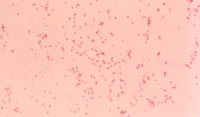
Photo from wikipedia
Background Antimicrobial resistant (AMR) Neisseria gonorrhoeae has emerged as a global public health concern. Widespread resistance to all known antibiotics prescribed for treatment greatly hinders prevention, control, and management of… Click to show full abstract
Background Antimicrobial resistant (AMR) Neisseria gonorrhoeae has emerged as a global public health concern. Widespread resistance to all known antibiotics prescribed for treatment greatly hinders prevention, control, and management of gonorrhea. Misuse of antibiotics and substandard antibiotic quality and dosing have contributed to the threat of untreatable gonorrhea. As a globally deployed force, the U.S. military is vulnerable to diminished operational capability and readiness as this threat looms overhead. Methods The need for rapid, timely, and actionable information for force health protection precipitated the establishment of the Department of Defense (DoD) Gonococcal (GC) Reference Laboratory and Repository in 2011. The aims of the Reference Laboratory are to monitor trends in AMR GC through confirmatory identification, antimicrobial susceptibility testing (AST) and advanced molecular characterization, and to improve N. gonorrhoeae culture capability at international DoD surveillance sites. To our knowledge, this is the only global AMR GC surveillance program led by a military organization. Results Gonococcal surveillance at international DoD sites is conducted at partner military medical centers, private medical clinics, and U.S. government-sponsored care clinics. Laboratories currently submitting isolates include: AFRIMS (Bangkok, Thailand); NAMRU-3 (Accra, Ghana); NAMRU-6 (Lima, Peru); USAMRD-G (Tbilisi, Republic of Georgia); and USAMRD-A (Nairobi, Kenya). To date, 436 presumptive isolates have been shipped, from which 247 isolates were confirmed as N. gonorrhoeae. Resistance is commonly observed in these isolates, particularly with respect to tetracycline, penicillin, and ciprofloxacin. Of greater concern, reduced susceptibility to azithromycin (MIC ≥ 0.125 µg/mL) and cefixime (MIC ≥ 0.06 µg/mL) have been observed. Conclusion The risk of AMR GC and the associated loss of convenient outpatient therapy is of great concern to the military medical community. Comparable data across geographically distinct regions is essential for monitoring AMR GC and implementing appropriate countermeasures in locations where service members are or could be deployed. Disclosure No significant relationships.
Journal Title: Sexually Transmitted Infections
Year Published: 2019
Link to full text (if available)
Share on Social Media: Sign Up to like & get
recommendations!